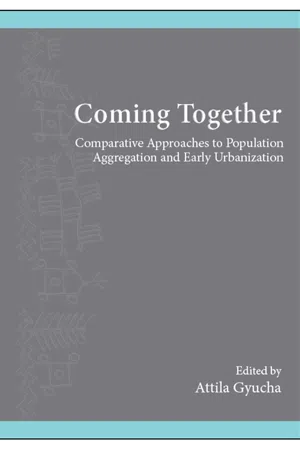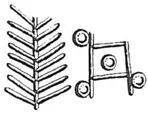![]()
| CHAPTER ONE |
| Population Aggregation and Early Urbanization from a Comparative Perspective |
| An Introduction to the Volume |
| Attila Gyucha |
“The technological developments in transportation and communication which virtually mark a new epoch in human history have accentuated the role of cities as dominant elements in our civilization and have enormously extended the urban mode of living beyond the confines of the city itself” (Wirth 1938:4–5). Wirth’s note penned 80 years ago is still just as valid today. Similarly to many others—particularly economists, such as Jacobs (1969)—Wirth called the growth of cities and worldwide urbanization as “one of the most impressive facts of modern times” (Ibid., 2), and states that “what is distinctively modern in our civilization is best signalized by the growth of great cities” (Ibid., 1). Yet, in the same paper, he goes on to describe the negative effects of urban life on humans by using one of the most extensive and eloquent vocabularies ever published to portray the calamitous impacts of urbanism. But if cities have such a miserable and devastating influence on the social and mental life of urban dwellers—as Simmel (1903) and others also so vividly described—why do people keep deciding to give up on living in small, dispersed communities and have moved into large settlements time and again for thousands of years? What do these “products of human nature” (Park 1925:1) offer that have always been so irresistibly desirable for people?
Wirth (Ibid., 10) argued that cities bring together people because they are different, and as a result, they are beneficial to one another. Likewise, Morris (2008:319) defined cities as sociopolitical mechanisms that produce human interaction, and Glaeser (2011:120) emphasized the importance of “connected creativity” that makes cities successful and productive social formations. Smith (this volume) notes that the increasing face-to-face interactions as population number and density grow stimulate a range of positive outcomes, including economic and urban growth as well as community formation. As Newman put it, the attraction of cities “lies in the opportunities that they create through networks of people” (2006:278). The dynamic interactions between these spatially condensed informal and formal networks—through individuals, groups, organizations, and institutions as nodal points—glue urban systems together. But why are these networks indispensable for the individuals?
Many sociological and anthropological studies conclude that although integration into multiple social networks may be attractive for several other reasons, it is the expected economic benefits—commonly, by taking advantage of previously established social ties and networks—that play a vital role in individual or group decisions about moving to cities (Bogue 1977; Browning 1971; Schiller and Çağlar 2009; Wang et al. 2015). These benefits are associated with a spatially concentrated population, socioeconomic heterogeneity, and an economy of scales, as cities are not only central places of services and functions for their immediate hinterlands but their external relations many times also include their participation in interregional and transregional networks (Capello and Nijkamp 2004; Hohenberg and Lees 1985; Orum and Chen 2003; Robinson 2005; Taylor and Derudder 2016). In addition to being “primary economic organs” (Jacobs 1969:6) for production, consumption, and circulation of goods, modern cities—partially through these external relations—are powerful and vigorous nodes for innovations and new ideas that give rise to cultural and political transformations at the global scale (Crane et al. 2016; Mumford 1961; Redfield and Singer 1954; Zeng and Greenfield 2015). Urbanization accounts for changes in the environment as well as in social order and practices, and cities are arenas to create, display, and reinforce social and economic inequalities (Colantonio and Dixon 2011; Gottdiener and Budd 2005; Musterd and Ostendorf 1998; O’Connor et al. 2001).
Taken together, the complexity of modern cities derives from a wide range of types and forms of interactions between integrative institutions and diverse social and economic networks of various scales. These interactions result in dynamic, constantly changing entities the rules and conventions of which are being continually challenged, reconsidered, and reconstituted by discovering formerly unexplored directions and introducing novel concepts.
Although this overview is a brief and simplified description of the current, highly urbanized world, some fundamental sociocultural dynamics in the development of past nucleated societies may have been similar. Therefore, in order to answer the question “How did our world become like it is today?” comparative studies between the present and the past must be applied. This conference volume approaches this question from the perspective of the ancient past using data from both prehistoric aggregated villages (sensu Birch 2013) and early urban contexts (see Smith 2007, 2016), collectively called “nucleated settlements” in this introduction. The 9th IEMA Visiting Scholar Conference brought together an international group of distinguished scholars to explore three major cross-cultural anthropological questions regarding variations in the trajectories of nucleated sites: (1) What factors and integrative mechanisms brought large populations together?; (2) What social practices and institutions facilitated the development and sustainability of these sites?; and (3) What were the impacts of permanent nucleations on sociocultural developments in ancient societies? With an overarching range of theoretical perspectives and methodological approaches, the chapters of this volume provide thoughtful insights into these matters through case studies from Europe, the Near East, and North America.
In the rest of this introductory chapter, following the initiatives of the conference listed above, I contextualize the chapters of the volume by discussing several theoretical and methodological issues related to the emergence, development, and sociocultural impacts of ancient nucleated settlements.
COMPARATIVE PERSPECTIVES IN THE STUDY OF NUCLEATED SETTLEMENTS
Comparative studies in archaeology are significant because they help to identify analogous and divergent patterns in the archaeological record, particularly in regard to cultural, social, political, and economic developments. Moreover, the constantly increasing quantity and quality of data can bring about more coherent explanations and models based on the recognized similarities and differences. As a result, comparative research also is complementary in nature, as this approach expands our interpretive schemes. Scholars agree that the systematic application of cross-regional and cross-temporal approaches results in a better understanding of past and present urban developments (Nijman 2007; Robinson 2015; Smith 2003a; Smith 2010; Smith et al. 2016; Ward 2008). In fact, many researchers convincingly argue for the prerequisite of comparative perspective in urban studies—as McFarlane put it, “When we make a claim about ‘the city,’ or about a particular form of urbanism, the claim is implicitly—and, crucially, inevitably—to some extent a comparative claim, because our claims and arguments are always set against other kinds of urban possibilities or imaginaries” (2010:725). Furthermore, systematic comparisons between past and present nucleation dynamics provide outcomes that help us understand current, many times pressing issues associated with modern urbanization trends.
Comparative research has documented common planning principles as well as regularities in social, economic, political, and religious mechanisms and practices in premodern urban settlements across the world. These studies, however, also pointed out a great deal of variation even in local and regional developments (e.g., Adams 1966; Blanton et al. 1993; Creekmore and Fisher 2014; Fernández-Götz and Krausse 2016; Smith 2003b; Storey 2006a). This dichotomy has been addressed and discussed from different angles. With regard to preindustrial urbanism, Storey concluded that it “is uniform throughout the world. Similar numbers of people could be fed and housed given the existing technology, transport system, hinterland productivity, and administrative structures available in the preindustrial era, which despite local variations, were similar all over the world” (1992:119). Renfrew (2008:36) noted that shared characteristics revealed in urban settlements are associated with the need to accommodate a range of similar functions. In addition to these functional approaches, others—such as Fletcher (1995) and Trigger (2008)—argued that cross-cultural regularities in the built environment of ancient cities indicate similarities in human behavior and thinking that may require various explanations. However, they may also act as launching platforms for comparative investigations.
Comparisons between ancient and modern cities had occurred in past urban studies, particularly with respect to architectural design (e.g., de Souza Briggs 2004; Kostof 1991; McIntosh 1991; Scargill 1979). The past 10 years, however, have witnessed the systematic application of a transdisciplinary approach based on, as Stanley and his colleagues (2015:122) stated, “the notion that urban areas throughout world history share commonalities” and “the guiding principle that present-day urbanism is better understood in the context of deep urban history.” New comparative studies of premodern and modern cities—using theories and methods borrowed from multiple disciplines—illustrate “how different societies developed analogous suites of solutions to related problems” (Carballo and Fortenberry 2015:542). These studies already have yielded encouraging results in the investigations of timeless urban principles and characteristics (Dennehy et al. 2016; Smith 2010; Vis 2014; York et al. 2011).
Previous research commonly linked the emergence of cities to state-level political configurations (e.g., Adams 1966; Childe 1950; Manzanilla 1997; Trigger 1972). Nevertheless, recent archaeological investigations—largely based on comparisons between different trajectories across the globe—have stimulated arguments for decoupling urbanization and state formation processes. These studies have triggered the notion that urban settlement forms preceded the rise of states, and cities occurred within a broad range of sociopolitical contexts in many parts of the world (Cowgill 2004; Jennings 2016; Jennings and Earle 2016; Smith 2003a; Wengrow 2015). These findings further reinforce the efficacy of approaches to trajectories toward social complexity that go beyond unilinear evolutionary typologies (Fried 1967; Morgan 1877; Service 1962; Spencer 1990). A growing body of alternative perspectives addresses societal development and power relations in more complex societies through archaeological and ethnohistoric studies. The outcomes imply nonlinear social trajectories as well as tremendous variation in political structures, ranging from collective and corporate systems to rigidly hierarchical and autocratic political formations, sometimes even occurring in neighboring, contemporaneous polities (Blanton et al. 1996; Drennan and Peterson 2012; Ehrenreich et al. 1995; Fargher et al. 2011a; Feinman and Neitzel 1984; Feinman and Price 2010; Neitzel and Earle 2014). A particularly valuable finding of these studies is that the data from nucleated settlements indicate a great range of variation in the potential combinations of settlement form and political organization. These recent, interrelated theoretical advances underscore the importance of analyzing local- and regional-scale trajectories in their own cultural and historical settings when various pathways to social complexity are studied as they relate to ancient settlement dynamics (Falconer and Savage 1995; Smith 2016; see also Gaydarska, Harrison, and Bilgen, and Sastre and Currás this volume).
Another paradigmatic shift has emerged in the past few years that has placed the comparative investigations of ancient and modern aggregated settlements in a new dimension. In addition to mutual qualitative properties revealed by transdisciplinary studies, settlement scaling research has demonstrated that several quantitative attributes and patterns shared by recent urban settings also commonly occurred in ancient cities (Bettencourt 2013; Bettencourt et al. 2007; Cesaretti et al. 2015; Ortman et al. 2014). Moreover, other related investigations indicate that sites classified as villages also tend to produce identical regularities (Ortman and Coffey 2015; Ortman et al. 2016; see also Smith this volume). Thus, scaling studies have provided empirical evidence for the operation of similar principal dynamics and mechanisms in the social development of nucleated settlements throughout human history to a considerable extent.
Apart from verifying the applicability of comparative studies into past settlement developments, the advances summarized briefly above have opened novel opportunities to explore prehistoric aggregated settlements and early urban sites using the same theoretical approaches. As previously urged by a number of scholars (e.g., Butz...

